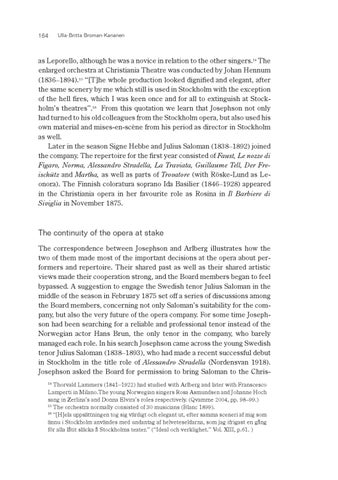164
Ulla-Britta Broman-Kananen
as Leporello, although he was a novice in relation to the other singers.14 The enlarged orchestra at Christiania Theatre was conducted by Johan Hennum (1836–1894).15 “[T]he whole production looked dignified and elegant, after the same scenery by me which still is used in Stockholm with the exception of the hell fires, which I was keen once and for all to extinguish at Stockholm’s theatres”.16 From this quotation we learn that Josephson not only had turned to his old colleagues from the Stockholm opera, but also used his own material and mises-en-scène from his period as director in Stockholm as well. Later in the season Signe Hebbe and Julius Saloman (1838–1892) joined the company. The repertoire for the first year consisted of Faust, Le nozze di Figaro, Norma, Alessandro Stradella, La Traviata, Guillaume Tell, Der Freischütz and Martha, as well as parts of Trovatore (with Röske-Lund as Leonora). The Finnish coloratura soprano Ida Basilier (1846–1928) appeared in the Christiania opera in her favourite role as Rosina in Il Barbiere di Siviglia in November 1875.
The continuity of the opera at stake The correspondence between Josephson and Arlberg illustrates how the two of them made most of the important decisions at the opera about performers and repertoire. Their shared past as well as their shared artistic views made their cooperation strong, and the Board members began to feel bypassed. A suggestion to engage the Swedish tenor Julius Saloman in the middle of the season in February 1875 set off a series of discussions among the Board members, concerning not only Saloman’s suitability for the company, but also the very future of the opera company. For some time Josephson had been searching for a reliable and professional tenor instead of the Norwegian actor Hans Brun, the only tenor in the company, who barely managed each role. In his search Josephson came across the young Swedish tenor Julius Saloman (1838–1893), who had made a recent successful debut in Stockholm in the title role of Alessandro Stradella (Nordensvan 1918). Josephson asked the Board for permission to bring Saloman to the Chris14 Thorvald Lammers (1841–1922) had studied with Arlberg and later with Franscesco Lamperti in Milano.The young Norwegian singers Rosa Asmundsen and Johanne Hoch sang in Zerlina’s and Donna Elvira’s roles respectively. (Qvamme 2004, pp. 98–99.) 15 The orchestra normally consisted of 30 musicians (Blanc 1899). 16 “[H]ela uppsättningen tog sig värdigt och elegant ut, efter samma sceneri af mig som ännu i Stockholm användes med undantag af helveteseldarna, som jag ifrigast en gång för alla låtit släcka å Stockholms teater.” (“Ideal och verklighet.” Vol. XIII, p.61. )
